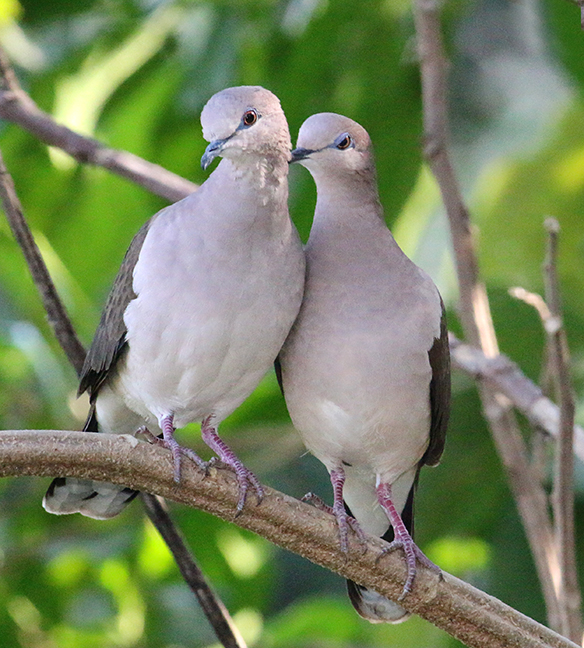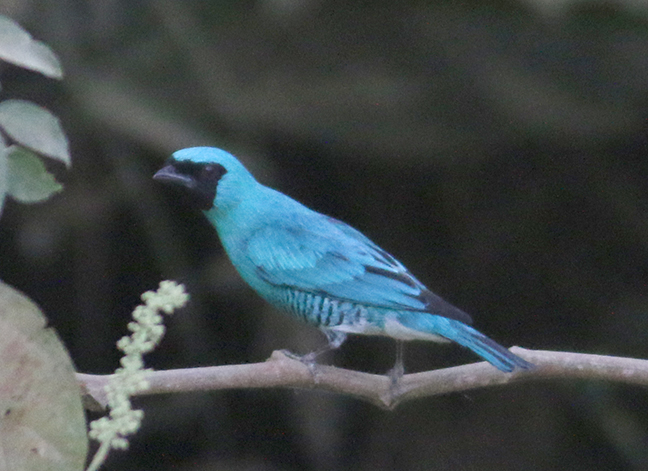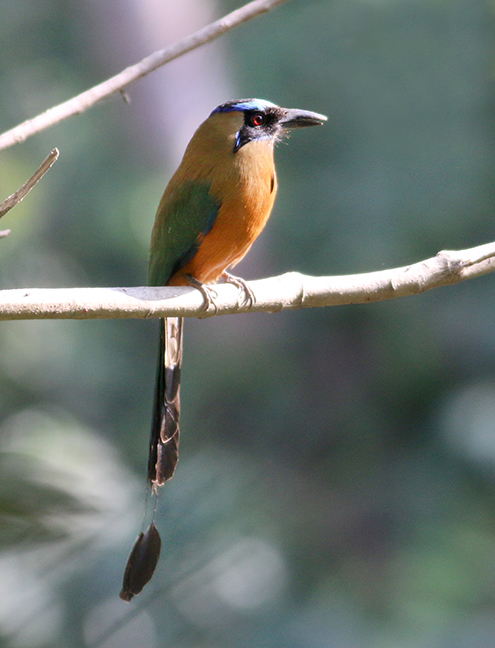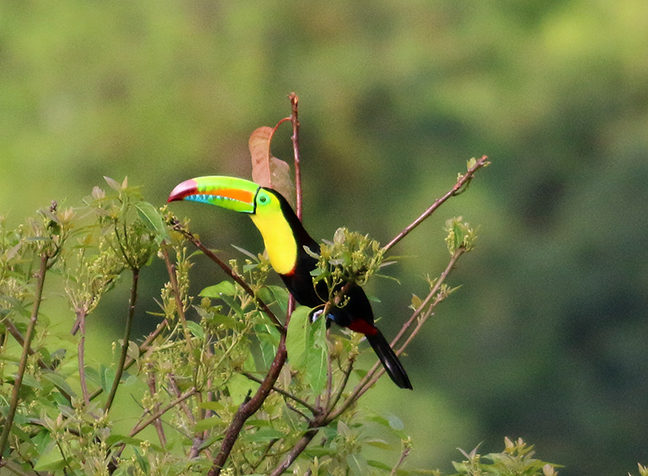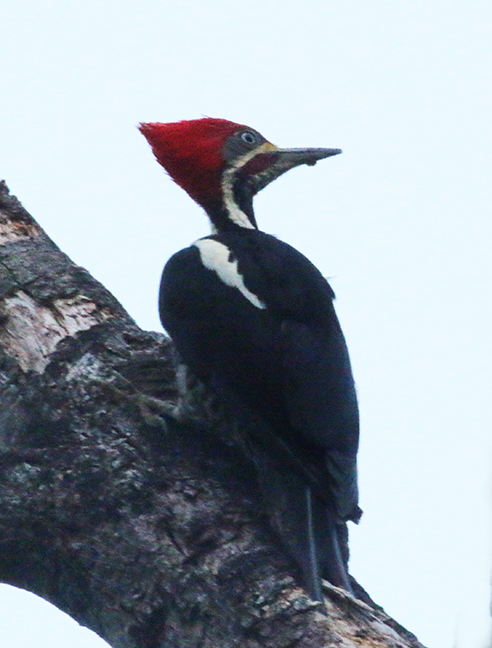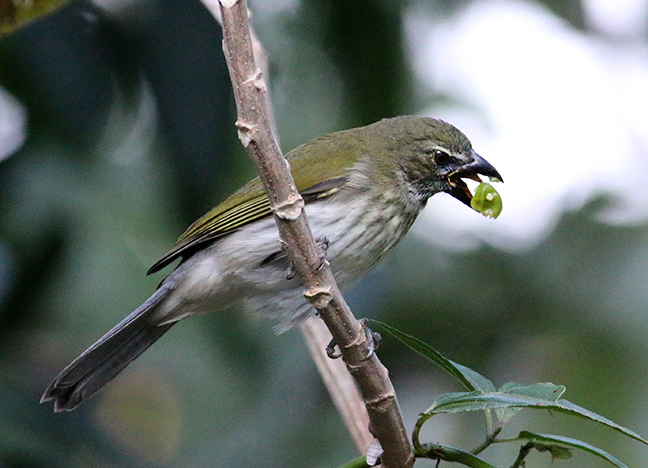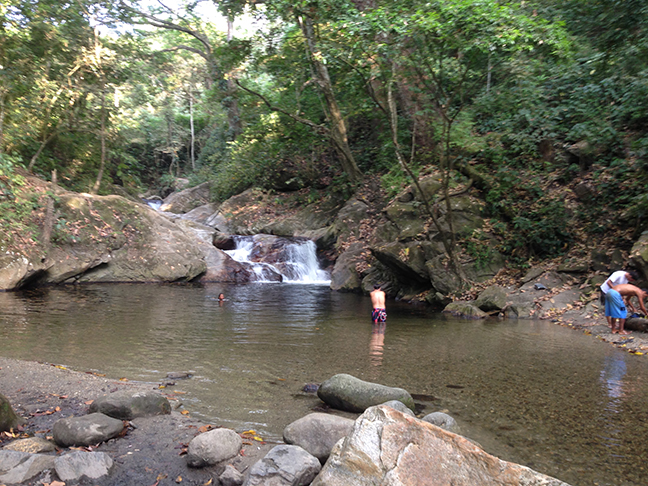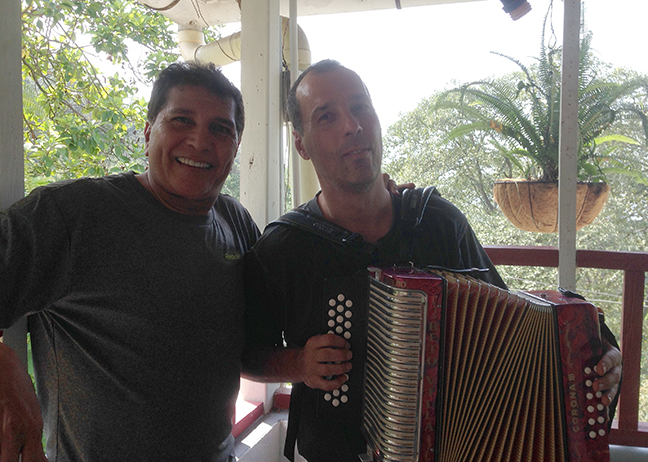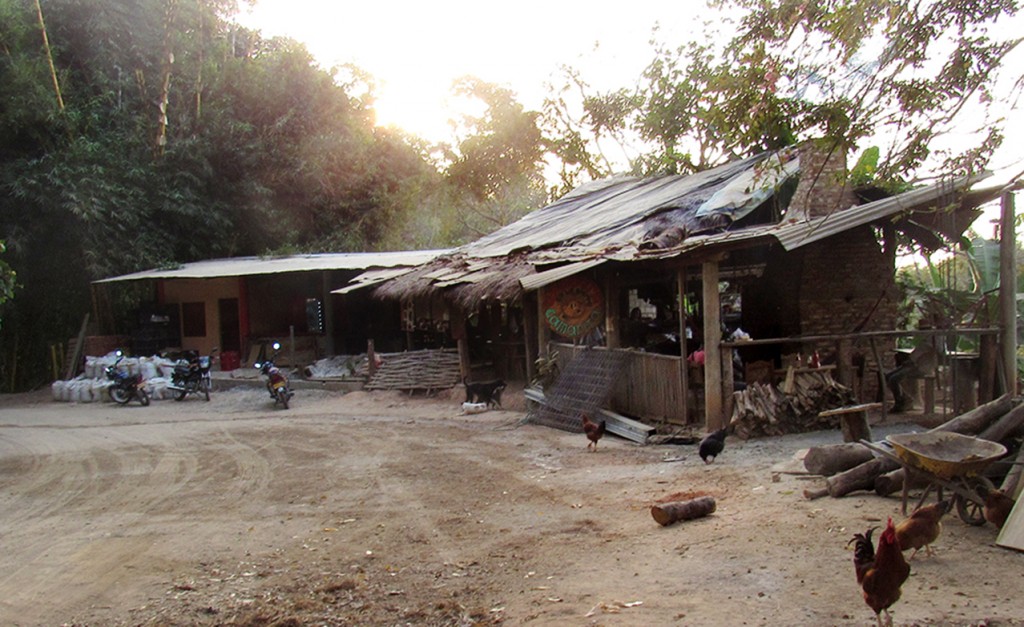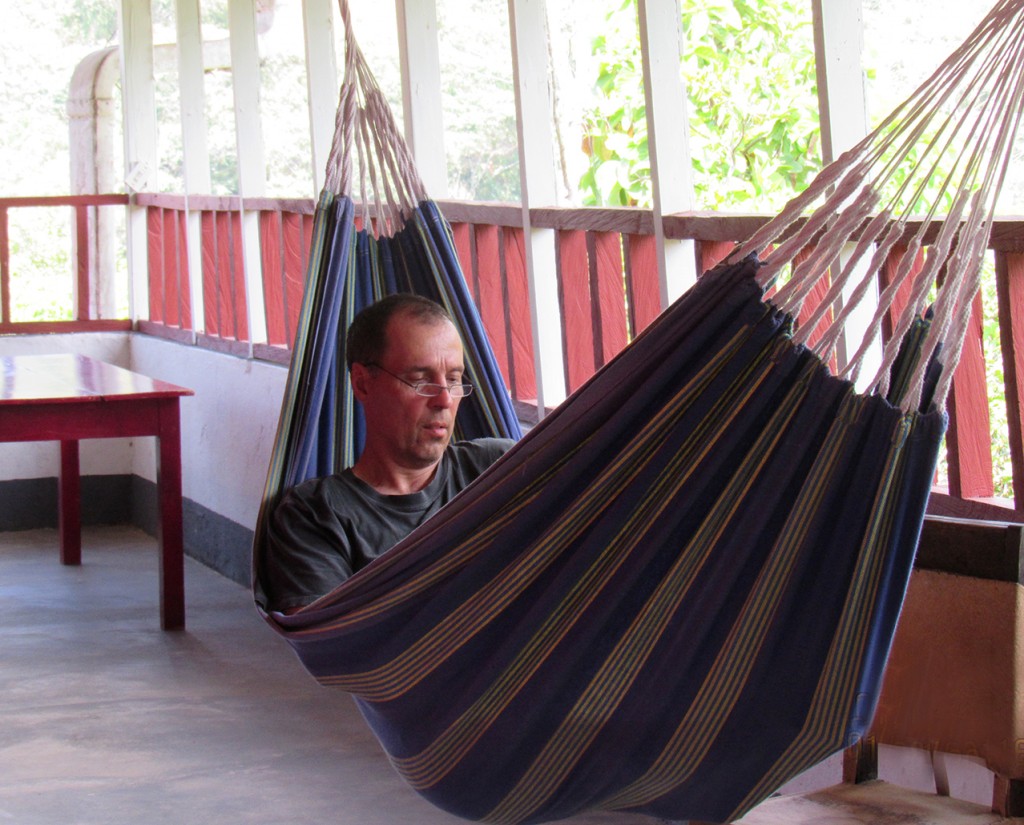The Sierra Nevada mountains of Colombia are renowned in the birding world. The highest peak in this coastal mountain range lies just 28 miles from the Atlantic Ocean, yet rises to a height of 18,950 feet. The Sierra Nevadas are separated from the Andes by a wide valley, resulting in a hotbed for endemic species and a group of near-endemic species that are shared with neighboring Venezuela. The main route to access these endemic species is a road that leads from the small town of Minca (located at ~2,000 ft. elevation) up to Cerro Kennedy (~7,700 ft.) at the top of the San Lorenzo Ridge. Within this relatively short distance it is possible to observe 19 endemic bird species.
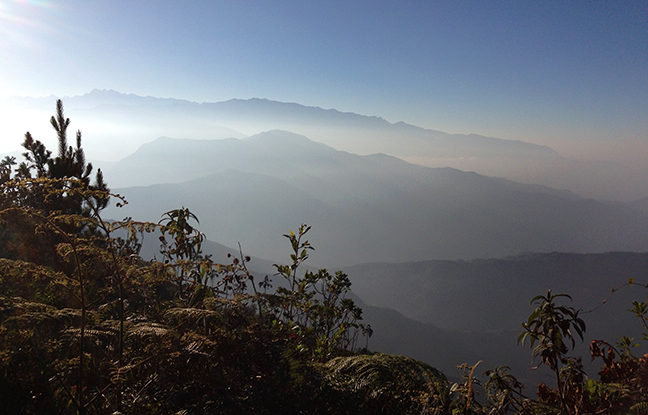
Morning view from near the top of the San Lorenzo Ridge. Peaks in the distance had some snow on top.
Before we get to the birds, allow me a few moments to discuss practical matters in case you are considering a trip here. First, it is generous to call the route up to Cerro Kennedy a road; it’s a road in the sense that it’s a wide unvegetated path through the forest, but don’t picture pavement or an even surface. Calling it a dirt road is more accurate but still misleading. It’s certainly the worst road that I have ever been on, requiring 4 wheel drive vehicle, enhanced clearance, a sturdy spine, and driving skills to avoid leaving car parts behind on the protruding rocks. To give you an idea of how rugged it is, near the top of the ridge above El Dorado Lodge we drove nine miles in three hours. That is a grand speed of THREE mph, which is an average human walking pace. Thankfully the road has been freshly paved up to Minca, but beyond Minca the road goes from bad to worse to will-the-vehicle-survive-this-drive. This might sound like exaggeration, but if you are going, be prepared for a rough ride and don’t be fooled by apparent short distances…a mile on that road is not equivalent to a mile on your road at home. Second, because of the road conditions, it is preferable not to travel the road more than is necessary. You certainly don’t want to drive up from Minca to El Dorado or beyond more than once despite their close proximity on a map. There are plenty of hostels in and around Minca, but at higher elevations there are not many places to stay overnight. The El Dorado Lodge currently costs more than $300 per night when rooms in comfortable hostels in Minca can be had for $20 per night, and the ProAves/EcoTurs people who run the lodge were far from cooperative. The Palo Alto hostel located about a mile below El Dorado would be a great affordable choice, but it was being renovated when we were there. So either be prepared to pay the ProAves fees or expect to rough it a bit. Finally, birding in this area is primarily road birding. That’s OK though, because it is a one-way dead-end road, so it doesn’t get much traffic in the higher reaches away from Minca. Motoscooters are the most common mode of travel, often with three family members on them due to the gas mileage and greater ease of maneuvering on the uneven road. Most of your time up here will be spent birding the road.

I don’t have great photos of the rougher sections of the road, but here is a fairly typical section.
Now on to the birds. One of the interesting things about birding this road is following the changes in species as the elevation changes. In the lower reaches, for example, Pale-breasted Thrush was common. As we drove upwards, eventually some Yellow-legged Thrush were observed, only to be replaced by Black-headed Thrushes higher up, and at the highest elevations, Great Thrush replaced the other species. Similar changes occurred in warbler species with Tennessee common near Minca, Blackburnian predominating in mid elevations, and Slate-throated and Yellow-crowned Whitestarts being found near the top. So when planning a trip here it is useful to spend time at the different elevations.
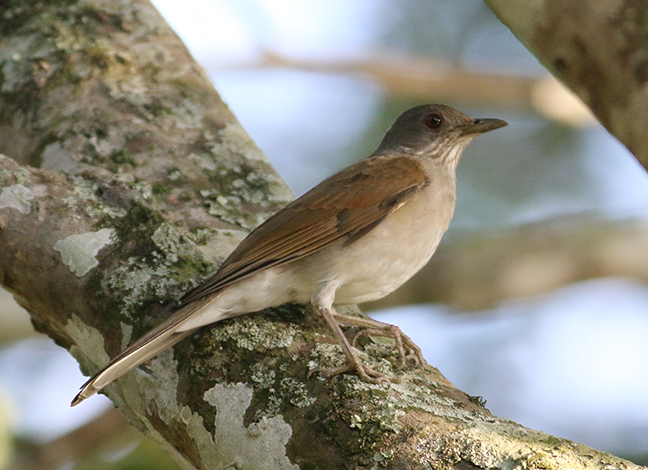
Pale-breasted Thrush, the most common thrush that we saw on this trip, especially at low-to-mid elevations.
Anticipating this distribution, our ‘plan’ was to spend two days each at low, mid, and higher elevations, but due to unexpected changes, we had only a single day of birding at the higher elevations, which is a shame because that is where the tougher endemics dwell. A few endemic species such as Santa Marta Brush-finch can be found at the lower elevations, but the tougher targets are typically found at higher elevations starting a little below the El Dorado Lodge area. If I was going to do this trip again, I would try to spend a night at the Research Station, which is considerably further uphill from the lodge. Still the birding was good. Here I’ll focus on the low-to-mid elevation section, from Minca to just below El Dorado, and in the next blog entry we’ll switch to the area around El Dorado Lodge and upwards.
We didn’t bird much in Minca itself, since our housing at this altitude was outside of town, maybe two miles up the road, at the Hotel Colonial and at the Faunal Nature Reserve. We did stop for lunch at the Minca Hotel, which hosted five hummingbird species at their feeders: Steely-vented and Rufous-tailed Hummingbirds, Black-throated Mango, White-vented Plumeleteer, and White-necked Jacobin.
While birding the road near our base at the Hotel Colonial we spotted a group of species that eventually would become commonplace on this trip: Crimson-backed Tanagers, Swallow Tanagers, Pale-breasted Thrushes, Buff-throated Saltators, Rufous-crowned Warblers, Red-crowned Woodpeckers, White-tipped Doves, and Black-chested Jays, along with some species that were less common for us: Collared Aracari, Whooping Motmot, Barred Antshrike, Keel-billed Toucan, Yellow-bellied Seedeater, White-bearded Manakin, Rufous-and-white Wren, Golden-winged Sparrows, King Vultures, Yellow-backed Orioles, Orange-billed Nightingale-thrush, Gartered Trogon, and Red-legged Honeycreepers, along with many other species.
It has been interesting to see how many of the species that we normally see up in NJ also appear here. The most common ones so far have been plenty of Prothonotary Warblers in the mangroves yesterday, and up here we are seeing good numbers of Tennessee and Blackburnian Warblers, and smaller numbers of Northern Waterthrushes, Black-and-white and Yellow Warblers, Rose-breasted Grosbeaks, and Summer Tanagers.
One morning we went birding with Sebastian on a short trail in Faunal, his small nature reserve located maybe a mile or two uphill from Hotel Colonial. Here we found a number of new species for the trip, including Long-billed Starthroat, Blue-black Grosbeak, Rufous-tailed Jacamar, Lineated Woodpecker, Streaked Saltators, and Gray-headed Tanager. We missed a Little Tinamou that was stalking through the brush and a calling Ferruginous Pygmy-Owl. A presumed Common Potoo was doing feeding runs just after dark when we were trying to locate the Night Monkeys that live on his property. Cool.
One more comment is worth mentioning here. Our trip was not just about birds, but also for relaxation and for interacting with the local people. One day we went swimming at Pozo Azul, a very popular swimming hole in the local river. Tourists are continually walking up from Minca or taking the motoscooter ‘taxis’ up here. It must be a zoo when lots of people are there; we stopped here for a swim late one afternoon when it was fairly quiet.
Another great episode occurred at the Hotel Colonial, where we stayed for two nights and which had hammocks outside of every room. As I was lying in my hammock one afternoon, I heard gorgeous accordion music (no that’s not an oxymoron!) coming from around the corner of the veranda. I walked over, and found Pete with two locals, one of which turned out to be an award-winning Colombian musician. We had fun with them.
Next entry: The El Dorado Reserve area and above.
